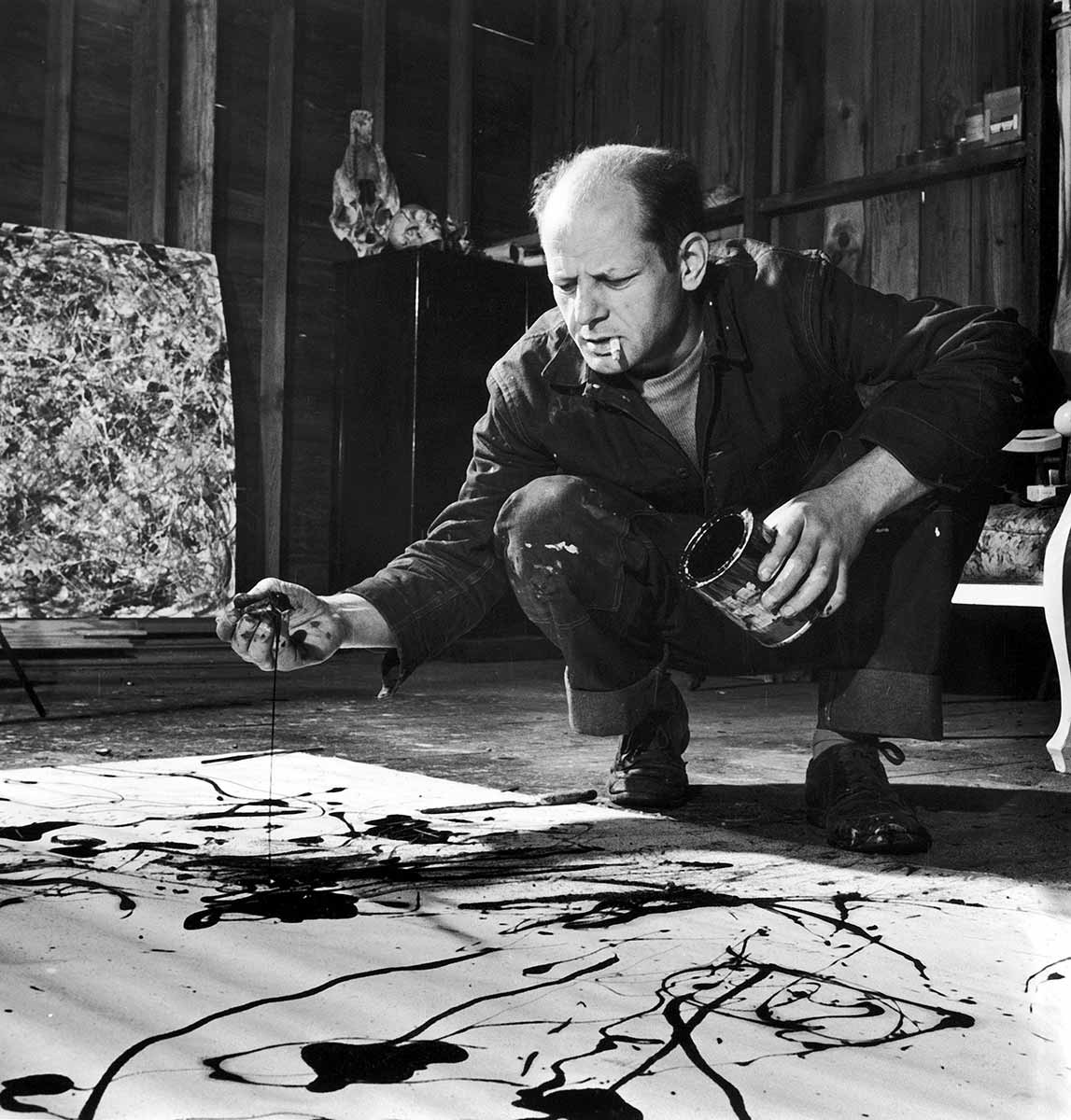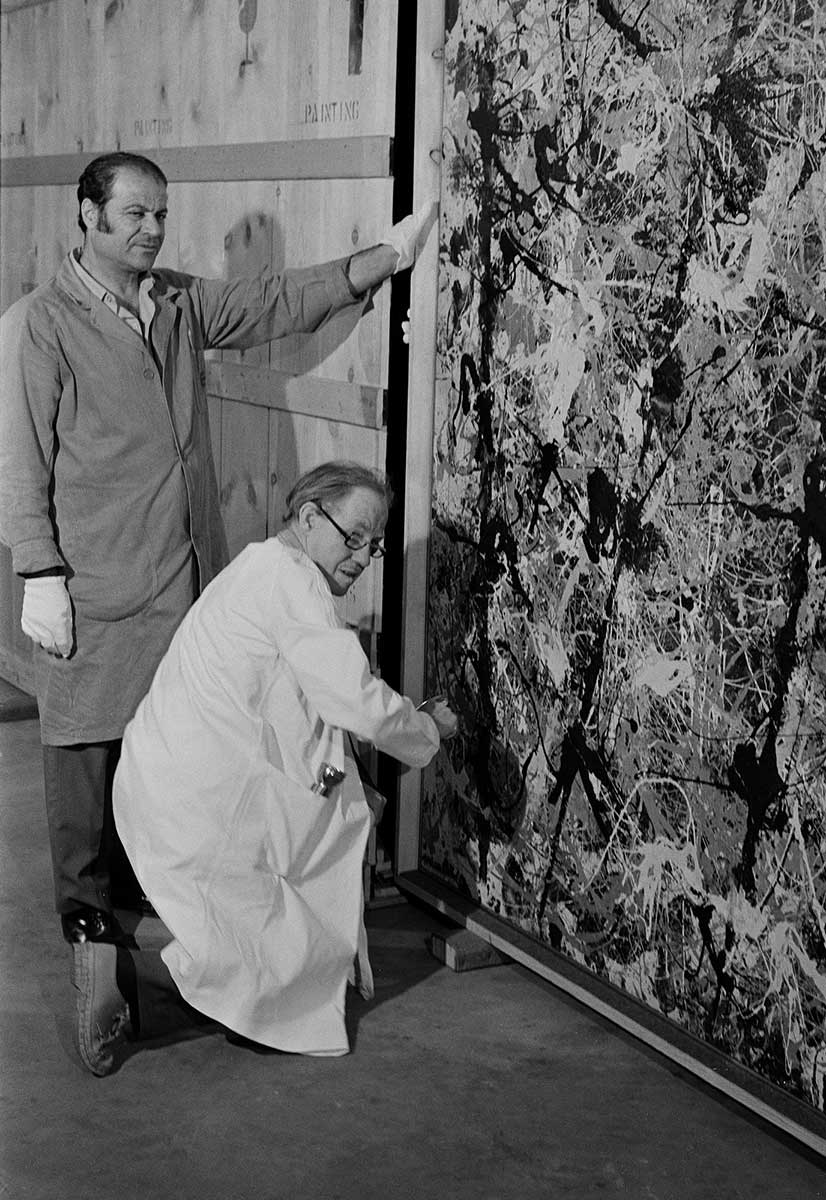In August 1973 the Australian Government, through the National Gallery of Australia’s acting director, James Mollison, bought Blue Poles by Jackson Pollock. The painting cost $1.3 million – the most ever paid for an American painting in the world at that time.
The newly established gallery’s acquisition was greeted with equal parts ridicule and approval by the Australian public and became part of the Whitlam government’s legacy.
Former prime minister Gough Whitlam speaking in 1976:
No country has a greater need than Australia, remote as we are from the great galleries of the world, to acquire works of art from other nations and civilisations … Overseas galleries have always recognised that the function of any gallery other than the most provincial is to offer a comprehensive view of world culture.

Artist Jackson Pollock
Jackson Pollock was born in Cody, Wyoming on 28 January 1912. His family were struggling farmers who moved several times during his early childhood.
In 1929 Pollock began studying art at the Student’s League in New York City and was influenced by aspects of Surrealism, Cubism and the work of Mexican muralists such as Diego Rivera and David Alfaro Siquieros.
It was the New York Museum of Modern Art (MoMA) exhibition, Picasso: Forty Years of His Art, held in late 1939 and early 1940, that introduced Pollock to the power of European modernism.
Abstract Expressionism
Most of the artists associated with Abstract Expressionism, also called the New York School, came to maturity between the Great Depression and the Second World War. They questioned the values of a society that could produce such widespread misery and trauma and were drawn towards leftist and radical politics.
The role of the unconscious in artistic expression and Jungian notions of universal archetypal symbols offered each artist a highly individual approach to making art. They valued spontaneity over reflection and emphasised dynamism and gesture.
Pollock was at the forefront of the Abstract Expressionism movement and in 1947 developed a radical new painting style that involved pouring and dripping paint onto large unstretched canvases laid on the ground. The paintings appeared to have no subject and their huge scale, power and unconventional technique were often confronting to viewers.
In his 1952 article ‘The American action painters’, art critic Harold Rosenberg said of Abstract Expressionism: ‘At a certain moment the canvas began to appear to one American painter after another as an arena in which to act rather than a space in which to reproduce, re-design, analyse or express an object, actual or imagined. What was going on the canvas was not a picture but an event.'

Whitlam and Australia's arts funding
The early 1970s were a turbulent era in Australian history. After 23 years of conservative Liberal and Country Party government, many voters felt that the Menzies era had run its course.
The Australian Labor Party under the leadership of Gough Whitlam was elected to government on 5 December 1972 with the campaign slogan ‘It’s Time’, which resonated with the electorate’s desire for change.
In less than three years in power, the Whitlam government passed a raft of progressive legislation that pushed the nation in a new direction.
Its laws and policies included the Racial Discrimination Act, no-fault divorce, equal pay for women, land rights for Indigenous Australians, abolishing tertiary education fees and increasing access to health care for all Australians.
The government made the arts a priority by doubling funding for Australian artists through the reconstituted Australia Council for the Arts.
Funding for visual arts increased dramatically with a focus on building the collection of the planned National Gallery of Australia in Canberra, whose budget increased 12-fold.
Mollison and Blue Poles
The National Gallery of Australia (initially called the Australian National Gallery) had been established in 1967.
The following year Prime Minister John Gorton announced that the winner of a competition to build the gallery was the architectural firm of Edwards Madigan Torzillo and Partners.
James Mollison was appointed as Arts Advisor to the Prime Minister that same year and was the Acting Director of the gallery from 1971 to 1977 when he was appointed Director, a position he held until 1990.
The gallery building was finally opened by the Queen in 1982.
Following the election of the Whitlam government in 1972, the gallery’s acquisition committee requested $5 million. The government approved a sum of $4 million and overnight the gallery had one of the largest acquisitions budgets in the world.
Given Pollock’s centrality in the New York Abstract Expressionism movement, James Mollison was keen to acquire one of his paintings. From the New York-based Australian gallerist Max Hutchinson, he discovered that Blue Poles (painted in 1952) was available for sale from the original owner for $1.3 million ($11 million in today’s money).
The acquisitions committee, which apart from Mollison included James Gleeson, Clifford Glass, Leonard French and Fred Williams, indicated their interest. A brief on the painting was prepared for Prime Minister Whitlam, as his approval was needed for such an expensive purchase.
Whitlam signed off on the acquisition and he personally announced Australia’s success in buying what MoMA called ‘the most important post-war American painting still in private hands’.

Blue Poles as a symbol
Blue Poles became the most controversial painting in Australian history.
Conservative elements of society saw the purchase as an indication of the Labor government’s flamboyance and economic ineptitude.
The Daily Mirror front page for 23 October 1973 announced ‘$1mill. Aust. Masterpiece. Drunks did it’.
Supporters of the acquisition saw the painting as symbolising a new, more internationally oriented, culturally mature nation. Both responses brought attention to the visual arts in a way never before experienced in Australia.
Legacy of Blue Poles
Blue Poles is the most viewed artwork at the National Gallery of Australia. The gallery has only lent the painting to other institutions twice (to MoMA in 1998–99 and the Royal Academy of Arts, London in 2016).
In 2016 Blue Poles was estimated to be worth $350 million, which means it has increased in value more than 30-fold.
The National Museum’s Garden of Australian Dreams includes several blue timber poles, an allusion to Pollock’s work, devised by landscape architects Richard Weller and Vladimir Sitta of Room 4.1.3.
Explore Defining Moments
References
Blue Poles, National Gallery of Australia
Lindsay Barrett, The Prime Ministers Christmas Card, Blue Poles and Cultural Politics in the Whitlam Era, Power Publications, Sydney, 2001.